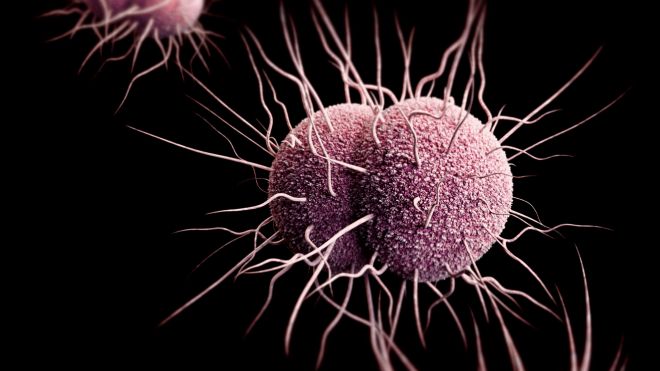Purpose
The adaptable health alert below is for health departments to notify local public health practitioners, clinicians, public health laboratories, and public information officers about a case, cluster or isolate of reduced susceptibility Neisseria gonorrhoeae in their jurisdiction. Use data from your jurisdiction to make it relevant to your community. You can customize this document by including details about the public health event, why it is significant, and links to local resources.

Customizable template
Summary
- As of [date], [health department] has identified [description of case, cluster, or isolates, timeframe, location]. NOTE: Discuss what resistance patterns you are seeing and among what population(s).
- CDC-recommended treatment is still highly effective for treatment of gonorrhea. To date, CDC has not identified a confirmed case of gonorrhea in the United States that was not successfully treated because of resistance to currently recommended treatment.
- Providers should continue using CDC-recommended treatment for gonorrhea (500 mg ceftriaxone intramuscular (IM) as a single dose for persons weighing <150 kg) (see STI Treatment Guidelines).
- Report immediately (within 24 hours) to the health department any suspected cases of gonorrhea treatment failure (i.e., someone with persistent symptoms or who remains infected despite recommended therapy after reinfection has been ruled out) to [name] at [phone], or after hours [number]. The health department can provide guidance on treatment and testing recommendations.
- [Jurisdictions can consider including] Laboratories are encouraged to maintain all Neisseria gonorrhoeae isolates demonstrating reduced cephalosporin susceptibility until further notice. [Jurisdictions can consider encouraging laboratories to maintain all isolates from patients with suspected treatment failures and can consider defining the laboratory thresholds for reduced cephalosporin susceptibility, such as ceftriaxone MICs of ≥0.125 μg/ml (used by the Gonococcal Isolate Surveillance Project) or ≥ 0.5μg/ml as per the Clinical & Laboratory Standards Institute (CLSI).]
Background
The [health department] has identified [description of case, cluster, or isolates, timeframe, location].
[Insert statement about why this is of public health significance, which may include characteristics of the public health event (e.g., the first such case, an increase in cases, the largest cluster) and that an isolate with reduced susceptibility was detected to the only remaining CDC-recommended treatment for gonorrhea (ceftriaxone).]
N. gonorrhoeae, the bacterium causing gonorrhea, has progressively developed resistance to the antibiotics prescribed to treat it. Following the spread of gonococcal fluoroquinolone resistance, the cephalosporin antibiotics have been the foundation of recommended treatment for gonorrhea. Health care providers should stay up to date on CDC treatment guidelines. The current CDC-recommended treatment for gonorrhea is 500 mg of ceftriaxone as a single IM dose for patients <150 kg. Following the recommended treatment guidelines every time may help slow the emergence of antimicrobial resistance.
Identification of N. gonorrhoeae infections with reduced ceftriaxone susceptibility can be a sign of emerging resistance. CDC-recommended treatment is still highly effective. To date, CDC has not identified a confirmed case in the United States of unsuccessful gonorrhea treatment due to resistance to recommended therapy.
Recommendations
- Screen for gonorrhea using nucleic acid amplification tests (NAATs):
- Screening should be performed at all anatomic sites of sexual exposure regardless of condom use, using pharyngeal swabs, rectal swabs, and either urethral/endocervical/ vaginal swabs or urine specimens.
- Women: annually in sexually active women <25 years old and women ≥25 if at increased risk for STIs (e.g., a new sex partner, multiple sex partners, a sex partner with concurrent partners, a sex partner with an STI, any STI during pregnancy, and exchange of sex for money or drugs). Pharyngeal and rectal gonorrhea screening can be considered in women based on reported sexual behaviors and exposure, through shared clinical decision making.
- Men who have sex with men (MSM): annually in all sexually active MSM and every 3 to 6 months in those with increased risk. Screening recommendations for transgender and gender diverse people should be adapted based on anatomy and reported sexual behaviors and exposure.
- Persons living with HIV: at initial HIV care visit and at least annually. More frequent screening might be appropriate depending on individual risk behaviors and local epidemiology.
- Pregnant people: all pregnant people <25 years old and pregnant people ≥25 if at increased risk for STIs (i.e., a new partner, multiple partners, a sex partner with concurrent partners, a sex partner with an STI, any STI during pregnancy, and exchange of sex for food or housing): If infected, treat immediately and retest within 3 months. Retest during the third trimester if <25 years old or if at risk.
- Rescreen all individuals (i.e., women, MSM, MSW, transgender and gender diverse people) with gonorrhea three months after treatment.
- Conduct a test of cure for all cases of pharyngeal gonorrhea 7–14 days after initial treatment by using either culture or NAAT.
- Treat gonorrhea (urethritis, cervicitis, and extra-genital gonorrhea) with ceftriaxone 500 mg IM once (for people weighing <150 kg)whenever possible (see STI Treatment Guidelines). Evaluate and treat the patient's sex partner(s) during the previous 60 days. [Include information on expedited partner therapy (EPT) if legal in your state.]
- Remain vigilant for patients not responding to CDC-recommended treatment. Contact [local STI program] about treatment failures by calling [name] at [phone], after hours [phone]. Symptoms that persist after treatment should be evaluated by culture for N. gonorrhoeae (with or without simultaneous NAAT), and any gonococci isolated should undergo culture-based antimicrobial susceptibility testing.
- All persons who are diagnosed with gonorrhea should be screened for other STIs, including chlamydia, syphilis, and HIV (see STI Screening Recommendations).
